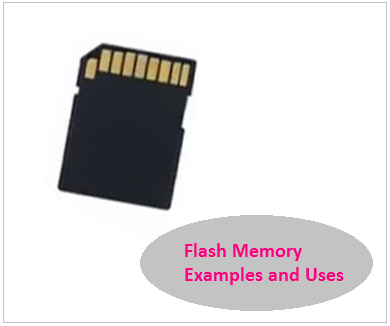Flash Memory Examples and Uses
Some common examples of Flash Memory are,
- Micro SD Card
- xD-Picture Card
- Smart Media Card(SM card)
- Solid State Drive(SSD)
- Pendrive
- General SD Card
- EPROM (Electrically Programmable Read-Only Memory)
- USB Sticks
- Mobile Storage
- USB Flash Drive
- NFC Tag Memory
Flash memory is a non-volatile memory where data storage and reprogramming both is possible. Flash memory can be reprogrammed electrically by an external device. Basically, flash memory is a semiconductor device and they are built with Metal Oxide Semiconductor Field Effect Transistor(MOSFET). There are two types of flash memory - NAND Flash and NOR Flash. The NAND flash memory is built with logic NAND Gates whereas the NOR Flash memory is built with logic NOR gates. Flash memory is much faster than normal volatile memory. It is an amazing replacement for Hard Drives. Flash memory was invented at Toshiba in 1980 by using EEPROM Technology.
You will see the use and applications of Flash Memory,
- Smartphone Storage
- Computer Primary Storage
- External SSDs
- Modem
- Digital Programmable devices
- Smart Electronic Cards
- Removable SD Memory Card
- Digital cameras
- Digital Audio Players
- Robotica Instruments and Machines
The main advantage of Flash Memory is that there is no requirement for constant power to retain the data. Once the data is stored using an electronic signal it can store or retain the data forever. We again need an electronic signal to reprogram or restore the data. The flash memory is built with floating gate MOSFETs and they are available in different types such as Single-Level Cell(SLC), Tripple Level Cell(TLC), or Multi-Level Cell(MLC). Data or information is stored in the flash memory in the array of memory cells. For a single-level cell flash memory, each cell stores or holds only one bit of information whereas in a triple-level or multi-level cell flash memory, each cell stores more than one-bit information.
The other advantages of Flash Memory are,
- High Speed
- Long Life Span
- Low Data Loss
- Less Power Consumption
- Easy and Time-saving data exchanging
- Compact size
- Low Noise and Distortion
According to capacity, there are different types of Flash memory are available in the market. Flash memories are available from a few megabytes to gigabytes for normal consumer use. For example in small gadgets, cards, and devices flash memory is used in a capacity of a few bytes or kilobytes. But the large and powerful consumer devices flash memory is used in high capacity in terms of megabytes, and gigabytes. The memory capacity of the flash memory is increased by following Moore's Law. Basically, multiple chips are arrayed or die-stacked to achieve higher capacities. Often nowadays flash memory replaces all the other types of memory such as hard drives, and magnetic memory due to its numerous advantages. There are a lot of companies in the market that manufacture Flash Memories such as SanDisk, Adata, Hama, etc.
Read Also:

